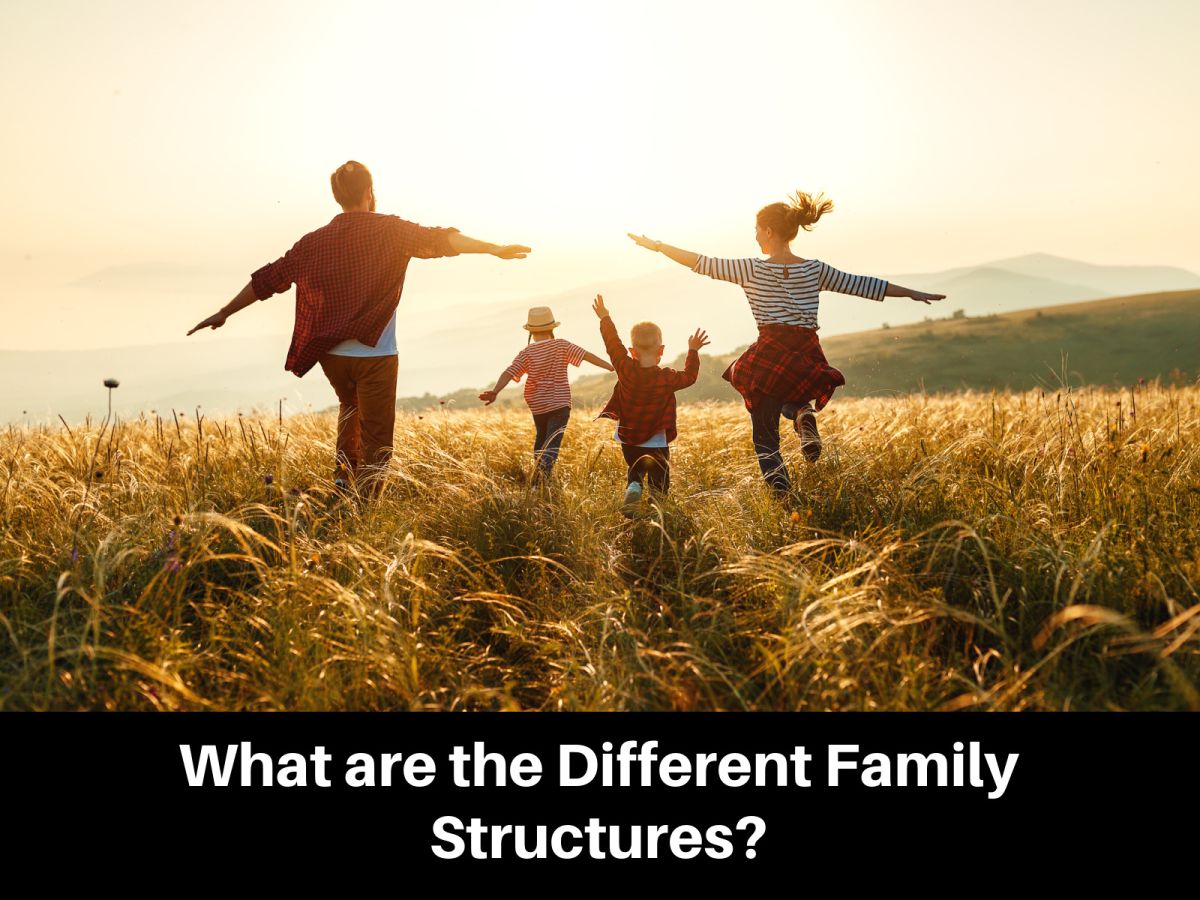There are many different family units in modern society, just take a look around the school playground at pick up time. There is no ‘one size fits all’ when it comes to family structure and no one type of family is better than the next.

Changes in society mean that families today can look very different from how they did during decades gone by. While the family unit can vary significantly, every one of us will have had (or still have) an immediate family.
Family Structure Definition
The term family structure refers to the group of family members to which a person belongs. A group of family members is also known as the family unit and it is possible to be a part of various family types.
If you have a partner and children, all living in the same household, then your setup fits into a nuclear family unit. If you also have parents, grandparents, cousins etc, you are one of many members of an extended family.
The nuclear family was the most popular family structure of the last decade, but changes in society mean the family unit is morphing and adapting to modern laws and views.
Family Structure Examples
Every family has its own quirks, inside jokes, values, and unique way of doing things, but they all fit into at least one of the following structures:
Nuclear Families
Nuclear families are family units that consist of two parents and their children. The parents do not need to be married and can identify as LGBTQ+. To be a nuclear family, both parents must be committed to each other and raise their children together in the same household.
The nuclear family has morphed over time. In the past, parents in this family unit were expected to be married and heterosexual – this is no longer the case. Also, children being raised in a nuclear family can be the parents’ biological children or be adopted.
In the past, the nuclear family was considered by sociologists to be the safest and most stable familial unit for raising children. In modern society, the view that ‘2.4 children and a white picket fence is best’ is often thought to be stereotypical and outdated.
Extended families
The extended family structure often consists of at least two adults living in the same household. Members of an extended family can be related by blood or marriage and can be spread across different generations.
If you have seen the Disney movie Encanto, La Familia Madrigal is a good example of what the extended family structure can look like. This type of family can include grandparents, cousins, aunts, uncles, parents, and in-laws, all living together, raising the children, and taking care of household chores.
Multigenerational households are most common in developing countries such as parts of Africa, Asia, and the Middle East. The extended family structure is also growing in popularity in Western cultures, with many families moving in together for financial reasons or for extra childcare support.
Single parent families
There are many different types of families in modern society but the one that has grown the most is the single-parent family unit. In the past, couples were expected to be married before having children. Also, divorce was not always as accepted as it is today, and many parents would stay together ‘for the sake of the kids’.
Times have changed and more people than ever before are having children outside of marriage. Marriage itself is also no longer as popular as it once was and recent census data shows that approximately 40% of children under 18 are being raised in a single parent household.
The single parent family structure consists of one parent raising their children alone at home. A single parent may have full custody of their children or have shared custody. Life as a single parent can be challenging but often children will develop strong connections with their parents, despite not having two caregivers present at home.
Childless families
The childless family structure can often be forgotten about as a group in society, but this type of family is in fact on the rise. A couple living together without children is still a family unit, even if they never intend on welcoming a baby into their lives.
Couples that are childfree may choose to get a dog or other pet to care for, or just enjoy life together as a duo. The US birthrate has been declining in recent decades and the childless family unit is growing in popularity.
Stepfamilies / Blended families
When parents get divorced or separate, and go on to form relationships with other people, a stepfamily is formed. Stepfamilies consist of a biological parent, their children, and a new partner.
For example, if your mom and dad split up and your mom got remarried, this man would be your stepfather. Stepfamilies differ from the single parent family structure as there are two adults – or caregivers – living at home and raising the family, even if one person is not the children’s biological parent.
When two families merge together, this type of structure is often referred to as a blended family. Children from the past relationships of both people in the new couple become members of a blended family and may spend some or all of their time living in the same household.
The custody of children within a step and blended families can vary. For example, in some family units, the children of one partner may only be there on weekends, while the children of the other parent may live in the family home full time.
Fostering and adoptive families
Recent data shows that there are over 400,000 children in foster care in the United States. A fostering family unit refers to a household where one or more adults are caring for children in the care system. Foster carers can look after children for just a day or several years.
There are many different reasons why children are taken into foster care and siblings do not always get to live in the same foster home. Kinship care is similar to foster care, but this family structure is different as the children are being cared for by relatives or close family friends – not by their birth parents.
In an adoptive family unit, one or more adults become the legal guardian and carers of a child that is not biologically related to them. Adoptive family structures can include one parent, LGBTQ+ couples or individuals, or a heterosexual couple raising one or more adopted children together.
How Does Family Structure Impact the Family?
Families in modern society can vary significantly and each has its own drawbacks and benefits. What works for one family won’t necessarily work for another, but it is important to acknowledge the role family structures have on the well being of all family members.

Childless families are often considered to be better off financially and have less stress, but couples may not be childfree by choice. Children growing up in adoptive families can experience unconditional love like children from a nuclear family, but they may have emotional challenges later in life if they learn they are adopted.
Adapting to life as a blended family can be difficult for all family members and creating a harmonious home environment may take a lot of time and effort. The extended family structure can result in a busy and chaotic household, but the household finances, chores, and childcare responsibilities can be shared between several adults in the family unit.
Changing Family Structures
Families in the United States today have changed along with the socioeconomics of the modern world. The traditional family unit is no longer the norm and each family structure has positive and negative characteristics.
Whatever type of family you belong to, as long as there are strong bonds and love between family members, it doesn’t matter what your family setup looks like. It is important to remember that all family structures have their place in society and there is no such thing as the perfect family.
